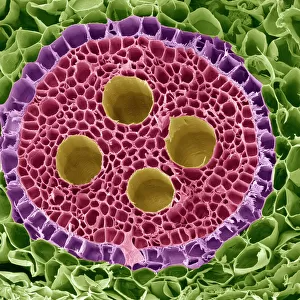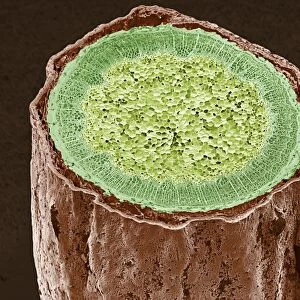Home > Fine Art Storehouse > Science Inspired Art
Water lily pollen grains, SEM
![]()

Wall Art and Photo Gifts from Fine Art Storehouse
Water lily pollen grains, SEM
Water lily pollen grains. Coloured scanning electron micrograph (SEM) of pollen grains from a water lily flower. Nymphaeaceae is a family of flowering plants, commonly called water lilies. Pollen grains are the male sex cells of a flowering plant. Their characteristic surface is used by botanists to recognise and classify plants. Pollen in plants is used for transferring male genetic material from the anther of a single flower to the stigma of another in cross-pollination. In a case of self-pollination, this process takes place from the anther of a flower to the stigma of the same flower Magnification: x200 when printed at 10 centimetres wide
Unleash your creativity and transform your space into a visual masterpiece!
STEVE GSCHMEISSNER/SCIENCE PHOTO
Media ID 19527313
© Science Photo Library
Cell Coloured False Coloured Exine Gamete Gametes
FEATURES IN THESE COLLECTIONS
> Fine Art Storehouse
> Science Inspired Art
> SEM (Scanning Electron Microscope)
> Fine Art Storehouse
> Science Inspired Art
EDITORS COMMENTS
This print showcases the intricate beauty of water lily pollen grains. Taken using a scanning electron microscope (SEM), the image reveals a stunning array of colors and textures that make these tiny particles come to life. Water lilies, belonging to the Nymphaeaceae family, are known for their enchanting flowers that float gracefully on still waters. Pollen grains play a crucial role in plant reproduction as they are the male sex cells responsible for fertilization. Botanists rely on their distinct surface features to identify and classify different plant species. The outer wall of these grains, known as exine, exhibits unique patterns and structures that aid in pollination. In cross-pollination, pollen is transferred from the anther of one flower to the stigma of another flower, facilitating genetic exchange between plants. However, self-pollination can also occur when pollen reaches its own stigma within the same flower. At a magnification level of x200 when printed at 10 centimeters wide, this photograph allows us to appreciate the remarkable details present in nature's smallest wonders. It serves as a reminder of both the complexity and elegance found within even seemingly insignificant elements like pollen grains. This mesmerizing artwork by Steve Gschmeissner invites us into a world where science meets artistry – where microscopic structures become breathtaking masterpieces worthy of admiration and contemplation.
MADE IN AUSTRALIA
Safe Shipping with 30 Day Money Back Guarantee
FREE PERSONALISATION*
We are proud to offer a range of customisation features including Personalised Captions, Color Filters and Picture Zoom Tools
SECURE PAYMENTS
We happily accept a wide range of payment options so you can pay for the things you need in the way that is most convenient for you
* Options may vary by product and licensing agreement. Zoomed Pictures can be adjusted in the Cart.






